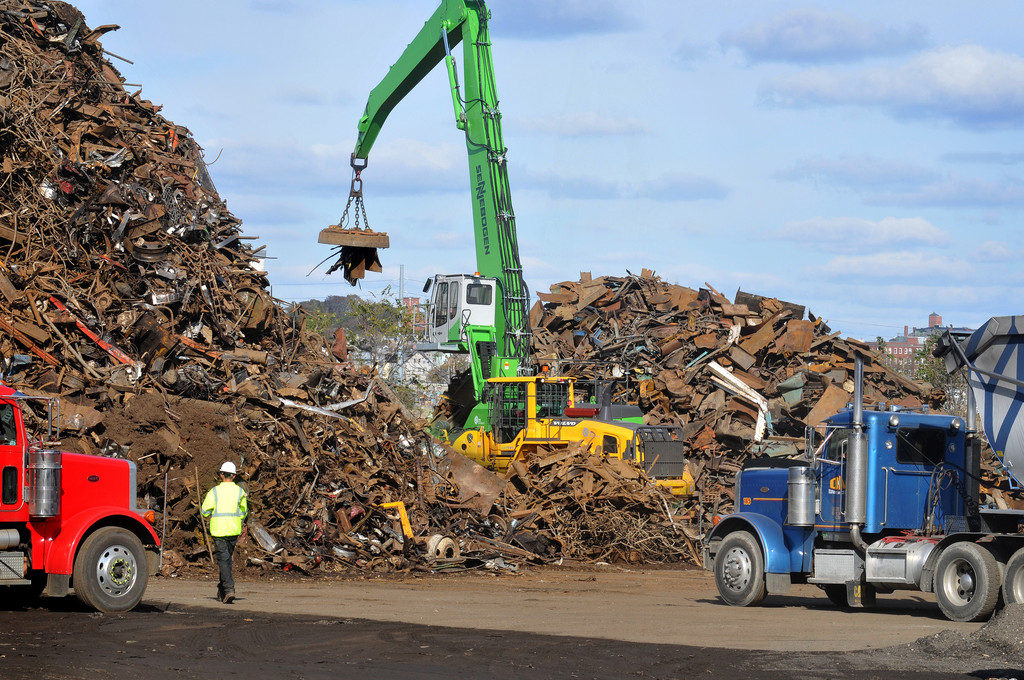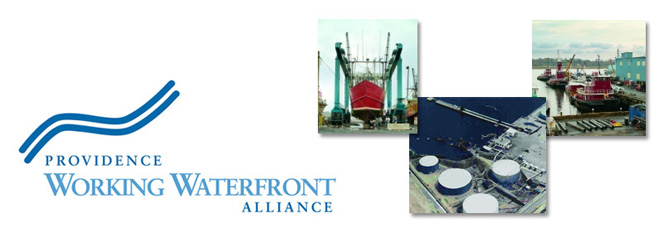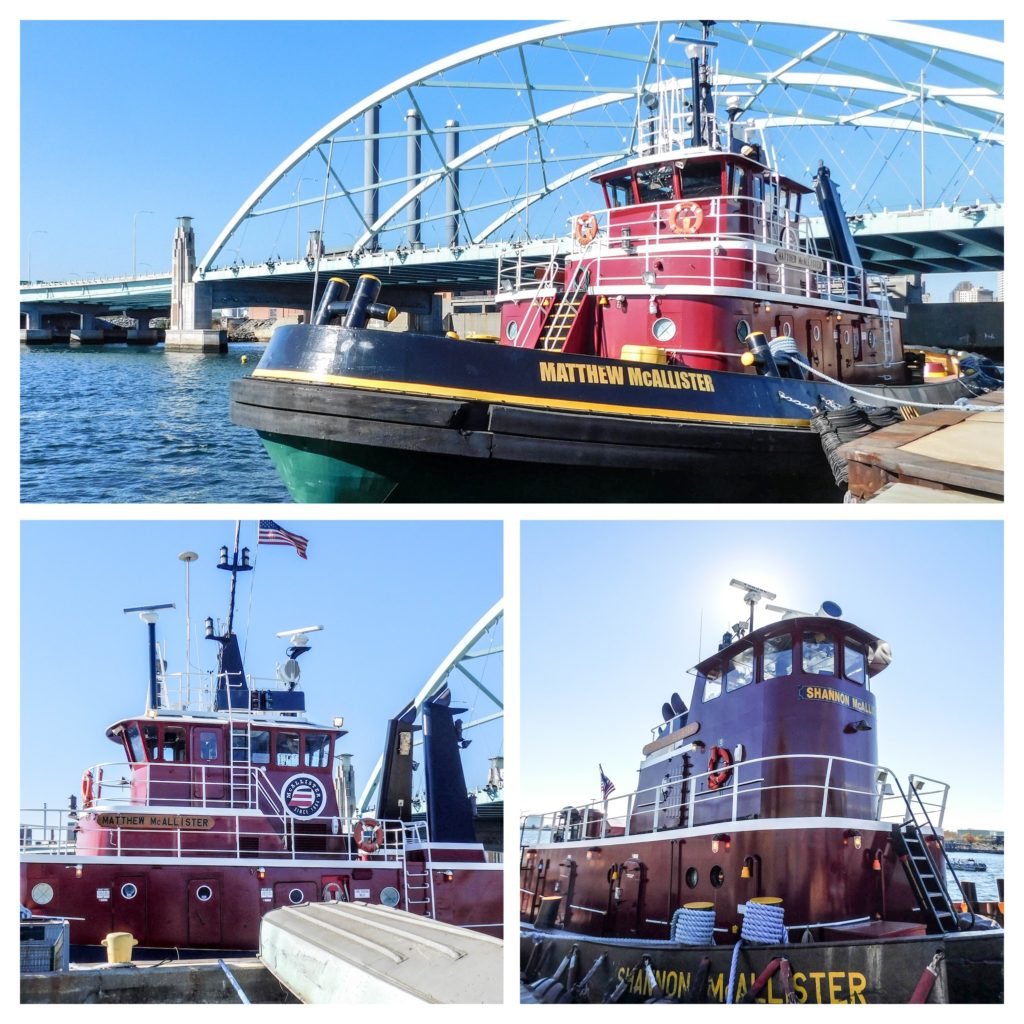Photographer Norma Smith stopped by earlier this week to snap a few shots of Providence Steamboat’s beautiful tugs.
National Journal article highlights importance of Port of Providence to region’s energy supply
April 23rd, 2015
National Journal has an excellent article,”A Deep-Water Port’s Key Importance to New England’s Energy Fortunes“, on the importance of the Port of Providence to supplying Rhode Island and the wider region with the energy products and other resources that power our economy.
Around the clock, hulking oil tanker ships that appear too massive to float glide to a stop in the Port of Providence, R.I. Massive hoses suck fuel from the ships. After finely tuned processing that’s specific to its final use, the fuel is pumped into waiting trucks that quickly head off to myriad destinations around the region.
Everything involved in the operation seems larger than life and the coordination of moving pieces is seamless.
Providence Working Waterfront Alliance Statement In Reaction To Candidate Vincent Cianci’s “Waterfront Plan”
October 7th, 2014
The Providence Working Waterfront Alliance is strongly opposed to candidate Vincent Cianci’s so called “waterfront plan,” which is little more than a rehashing of the failed Narragansett Landing plan released by Mr. Cianci some 15 years ago. Put simply, this “plan” threatens hundreds of good paying blue collar jobs and over a thousand related jobs provided by water-dependent and industrial businesses along the Allens Avenue corridor in the Port of Providence. Hotels, condominiums, and recreational marinas are simply incompatible with the heavy industrial character of our neighborhood.
Mixed use means densely clustering compatible uses. It does not mean placing obviously conflicting uses directly next to each other. For example, locating a hotel or condominium directly in-between an oil terminal, an asphalt plant, and a major metals recycling export and marine repair facility. Hotel guests and/or residents would surely complain about the loud noises and 24-hour operations of directly adjacent industrial businesses. This in turn would lead to pressure to place restrictions on these businesses, thus threatening their ability to operate.
While the only “mixed use” project in the area went bankrupt in 2010, the industrial businesses on Allens Avenue have thrived and attracted tens of millions of dollars in investment. This has been made possible by the strong industrial zoning passed by the Providence City Council and signed into law by Mayor Angel Taveras in August.
Rather than threaten our area with clearly incompatible uses, Providence city government should work to promote, market, and grow our industrial working waterfront. A unique asset that supplies good paying blue collar jobs and the critical commodities that power our region’s economy.
According to a report by the Business Roundtable, Rhode Island ranked 10th in the nation with $641 million in scrap exports in 2012. These scrap exports are made possible by Providence’s deep water channel and industrial zoning for our working waterfront, a key economic asset for Providence, Rhode Island, and the wider region.

Providence Business News photo. Pictured: Sims Metal Management operation on Allens Avenue in the Port of Providence.
Located in Fall River, Seaboats Inc. employs more than 100 people who build tugboats and provide tug and barge transportation services. In the video below, Seaboats founder Capt. Don Church explains why in the 1990s he was forced to move his company from Providence to Fall River due to the uncertainty over rezoning Providence’s working waterfront to allow for condos.
October 16, 2007 Narragansett Bay Propeller Club presentation.
Working Waterfront Alliance member Jack Goodison has a letter to the editor in today’s Providence Journal about how Boston has protected and invested in its marine industrial resources:
As city planners work on the details of Providence’s comprehensive plan, they should look to what Boston has done to protect working-waterfront areas.
In the 1970s and ’80s Boston purchased former military bases on the outskirts of Boston Harbor in South Boston. Resisting condo and hotel developers, the city chose to invest in and protect its deep-water marine resources. That investment is now paying off. In September of this year, the city approved a $130 million Boston Cargo Terminal project that will provide multi-modal ocean, rail, truck and air transportation for bulk cargo, seafood-processing and warehouse businesses.
The city is also promoting its Boston Marine Industrial Park, which has recently received several proposals from developers.
Combined, Boston’s marine industrial facilities house 180 businesses that employ 3,000 workers.
We could have the same success in Providence, if only our city planners would recognize the value of the deep-water channel we have right here in Providence Harbor.
The latest issue of 41°N, a magazine published by Rhode Island Sea Grant and the University of Rhode Island Coastal Institute, has an excellent summary of a spring stakeholders workshop about the future development of Providence Harbor:
As you drive along Interstate 95 in Providence, south of the state house, the hotels, and the mall, cast your eye towards Allens Avenue and Providence Harbor. When you look at the smoke stacks, industrial buildings, salt pile, and fuel tanks, are you seeing an eyesore, an unfair burden on the city of Providence, or an economic engine that is vital to the city, state, and region?
William Coffey, interim director of the Maritime Affairs Institute at Roger Williams University School of Law, has an excellent op-ed in today’s Providence Journal about the incredible economic opportunities for U.S. ports being created by increased international sea trade. Ports across the country are taking advantage of these opportunities. With the proper protections and economic development policies, the Port of Providence and Quonset could benefit as well:
For well over a decade, America’s international sea trade has been growing at unprecedented levels. Today, both cargo export and import volumes, whether in containers or via other means, are burgeoning, and all indications point to this trend continuing for the foreseeable future. This has been a particularly welcome development for U.S. Atlantic Coast ports. Much of the increase is coming from China, with “all-water-services” via the Panama and Suez canals increasingly used by ocean carriers and their customers to avoid delay and additional expenses associated with Pacific Coast gateways.
From the ports of Houston and Miami in the south to New York and Halifax in the north, terminal operators and port authorities are working diligently in tandem with their ocean carrier customers to meet these new demands.
The Port of New York and New Jersey and the Port of Savannah, for example, are focused on the container megaport/large-distribution-center model. Baltimore is building its automobile and roll on/roll off lines. Philadelphia and Wilmington lead in handling refrigerated commodities.
Boston and Halifax have been developing strong regional operations based on their compact container facilities. There are large private investments being made in these and other locations, and public/private partnerships are also being used to keep pace with trade.
“We were lured to downtown being told one thing, and we were duped. This is an upscale place, and it should have a certain tonality. Instead, my home is now a source of my stress. You’re lying in bed at night, the headboard’s going boom-boom-boom,” she said.
It’s the downside to the new downtown. The clubs and bars that have long dominated are now coming into conflict with the high-end residences that have sprung up in the last few years. Both feel they have the right to exist, exposing an at-times uneasy relationship between the established businesses and the moneyed newcomers.
The story is a perfect illustration of what will happen if condos are built right next to industrial facilities along Allens Ave. Future condo owners are certain to complain about the loud noises and industrial activity produced by typical working waterfront operations. And with complaints will come political pressure for operating restrictions that would eventually force many working waterfront companies out of business.
Unlike Providence city planners, who only envision luxury condos, hotels, and marinas as the future for our industrial waterfront, the city of Boston has protected its marine industrial resources and is now seeing that investment payoff. In September, Boston officials approved a $130 million Boston Cargo Terminal project:
After years of proposals and approvals for mostly mixes of luxury residences, hotels, and office developments on the harbor’s edge in the city, traditional water-related activities have made a distinct comeback along an 800-foot dock in the Boston Marine Industrial Park.
The new Boston Cargo Terminal, as the facility is to be called, will have multiple tenants including those handling seafood. It will accommodate ocean, truck, rail, and air transportation and – though no tenants have been disclosed – is expected to have seafood processors, cold-storage facilities, and warehouses.
Yesterday, the city approved a $130 million plan by the developer, Marine Terminal Development LLC, for three buildings totaling more than a half-million square feet, and a 4.3-acre bulk cargo facility to import and export concrete materials.
In addition to the cargo terminal project, Boston officials are busy promoting their Marine Industrial Park and are reviewing several proposals for large-scale maritime and industrial projects.
On Wednesday, November 28th at Save the Bay at 7 p.m., the Providence Planning Department is sponsoring “The Future of Our Waterfront: The Bay City Project” symposium. At the symposium, RISD students will be presenting their research into other waterfronts around the world.
Since no Working Waterfront Alliance members have been included in this project to date, we look forward to the opportunity to share our knowledge of working waterfronts at the symposium.
We are also pleased that the Planning Department moved the symposium from its original location at Conley’s Wharf (see original event flier), a facility owned by a developer with an active redevelopment proposal before the department, to a neutral location.
Tiffany Smythe, a Providence resident and a fellow at the University of Rhode Island’s Coastal Institute, has an excellent op-ed piece in today’s Providence Journal about the need for thoughtful city and state-wide planning for our ports and waterfronts:
Why do working waterfronts have value? To many, this question comes down to numbers: jobs versus property- tax income. While condominiums are often viewed as more lucrative because they will generate more tax revenue for a city, working-waterfront businesses contribute economic value to the residents, city and to the region. They offer high-paying, skilled jobs to marine tradesmen, and provide access to much-needed products such as fuel and construction materials. These products, and the many other services provided by Providence’s waterfront industries, benefit not only the city of Providence, but also the entire state of Rhode Island.
The value of shipyards and port facilities extends far beyond their proven economic return. Working waterfronts also have non-market benefits, such as cultural value. Working waterfronts are our connection to our history, and in New England, that means maritime commerce. It is ironic that here in the seaport city of Providence, the state capital and just downriver from the birthplace of the American Industrial Revolution, maritime industrial businesses have felt compelled to launch a public-education campaign to ensure their longevity. Rhode Islanders should not forget the importance of maritime trade to the colonial growth of the “city-state.”
Furthermore, working waterfronts have aesthetic value. While some may look at commercial/industrial parts of the Providence waterfront as an “utter stain” (to quote from Lee A. Johnson’s Sept. 27 Journal letter), others see beauty — fishing trawlers, tugboats, ferries and the occasional tall ship, framed against the backdrop of the Providence River.
Last night the Providence City Plan Commission held a meeting to discuss the Providence Tomorrow Comprehensive Plan as passed on November 1st by the City Council. Once again, the Providence Working Waterfront Alliance asked that the plan be amended so that the Allens Avenue Corridor’s land use designation not be changed from the current industrial only to mixed use/residential before our neighborhood charrette is completed. While the Plan Commission did not adopt our suggested amendment, Chair Stephen Durkee is quoted in today’s Providence Journal article saying that no zoning variances will be granted to waterfront developers until the charrette process is complete:
“If someone petitions for a zoning variance of this map, it won’t fly,” Durkee said. “Fact is, that map is just a piece of paper.”
We appreciate this commitment and will be vigilant in ensuring that the Plan Commission upholds its promise.
Today’s Providence Journal has an op-ed by Councilman Solomon defending the city’s passage of the “interim” comprehensive plan. The op-ed simply reiterates all of the same “protections” the council mentioned the night they voted to pass the plan. The Providence Working Waterfront Alliance remains deeply concerned about the process going forward. Our main concerns are that:
1. Condo developers will point to the “interim” comprehensive plan as the official guiding document for the city. As the Rhode Island Supreme Court has held:
“We believe a comprehensive plan is not simply the innocuous general-policy statement the town contends it is. Instead, the comprehensive plan, comprised of ‘text, maps, illustrations, or other media of communication,’ establishes a binding framework or blueprint that dictates town and city promulgation of conforming zoning and planning ordinances.” Town of East Greenwich v. Narragansett Electric Co., 651 A.2d 725, 727 (R.I.1994)
Pointing to the plan’s proposed mixed use Land Use change along the Allens Ave. corridor, developers will argue their plans are consistent with the city’s vision for the area and they should therefore be granted a variance. This could happen before of any charrettes or final zoning ordinance changes are approved by the Council.
2. Charrettes will be mere charades as the city moves forward with its vision for neighborhood zoning changes regardless of community feedback.
3. Comp Plan language stating that future residents must understand that the noises, odors, and vibrations caused by working waterfront operations will not be considered a nuisance, is completely unenforceable. It is inevitable that future condo residents would exercise their First Amendment rights to complain about their industrial neighbors and pressure their elected officials to pass operating restrictions.
Finally, we have noted with concern that the city Zoning Board of Review on Tuesday voted to grant a major variance for a proposed 12-story residential condominium building near Federal Hill. This variance was granted despite the Council’s promise, outlined in today’s Projo op-ed, that “existing zoning, as well as existing uses, density and character, will remain in place until changed by the council.”
For all of these reasons, we will remain vigilant in holding the Council to its word, as outlined in today’s Projo op-ed.
Providence Working Waterfront Alliance member Ellis Waldman of Walco Electric has an op-ed in today’s Providence Journal about how the city’s new comprehensive plan could drive out established businesses and good jobs:
Today, we struggle to bring new businesses into Rhode Island; we even struggle to agree on how to develop Quonset Point, with its unique characteristics, farther to the south. The Allens Avenue area from the Port of Providence to the Route 195 overpass has been stable for a long time. It hosts long-established companies, not just those requiring the river, whose activities cannot be scooted off to China, India or any other low-cost labor supplier — companies that employ hundreds of people.
Furthermore, the docks, the Providence River channel and the railroad spurs are resources that will no doubt be needed in years ahead as the cargo and freight industries in the U.S. continue their rapid growth. Indeed, the Port of Providence, including Allens Avenue, already has what we are trying to create in other parts of the state with enormous difficulty.
Why give that up? Why chase those jobs away? Why run the risk of pushing these companies out of Providence and the state? Can Providence really afford to lose jobs and businesses that could otherwise remain or be attracted to this area?
Not easily, I suspect. Worse, for those of us along the “working waterfront” who do not specifically need the Providence River for our business, we would have little incentive to relocate in Providence if this ill-conceived plan displaced us. Why? Because there is very little city space zoned for our type of industry.



